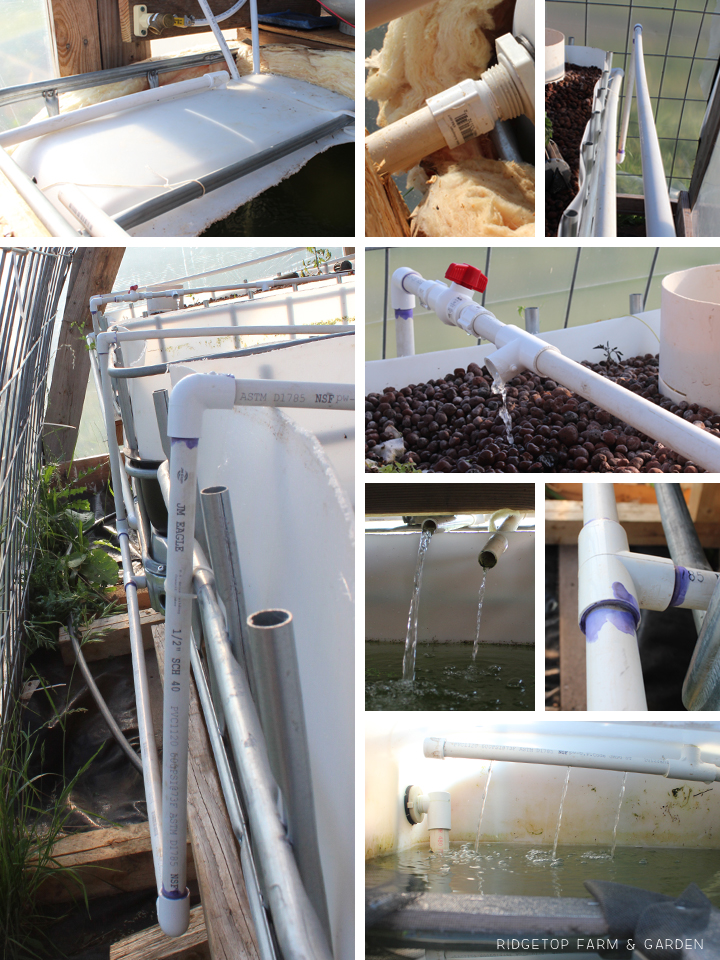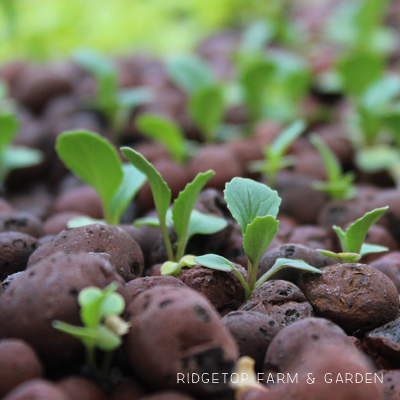The most exciting thing happened this month. We got our tilapia! Fifty of them.
Farmer John also worked on getting the plumbing & heating all figured out.
TILAPIA
Fifty of the tiniest fish arrived. Woo hoo! Farmer John made them a nursery out of styrofoam and screen door netting.
GROW BED
We have one grow bed up and running. It has lettuce, Chinese cabbage, arugula & a couple tomato plants started.
PLUMBING
After much trial and error last month with the poly pipe, Farmer John was ready to commit this month with the real deal & plumb the system using 1/2″ pvc pipe.
Top Left: Sump tank water being pumped to fish tank
Top Middle: Overflow pipe that carries water from fish tank to sump tank.
Top Right: Distribution Pipe. Water is pumped from sump tank to grow beds & fish tank equally
Middle Right: Laying across each grow bed is a pvc pipe, capped at the end. Each pipe has 3 tees, which allows the nutrient rich water to flow & spread out throughout the grow bed. Each bed also has a gate valve to control the amount of water coming in.
Middle: The bell siphons in the grow beds drain into these pipes feeding water into the sump tank. They are gravity fed, so they must be placed at a slight angle.
Bottom Left: Sump tank water being pumped to grow beds
Bottom Right: The pipe on the left of the main tank is a siphon that draws water up from the bottom of the tank bringing with it all the good fish waste, then it is carried to the grow beds.
Water from the sump tank is distributed into the main fish tank through the sprayer. The sprayer is used to aerate the water. There are 1/8″ holes drilled in the pipe. They get plugged occasionally but are easy to clean.

HEATING THE WATER
This has been one of the learn as we go parts of the system. We, unfortunately, have the problem of our power going out frequently. We chose to grow tilapia, and they need warm water. So, we had to come up with a way to keep the water warm even when the power is out.
Farmer John’s original plan:
A propane on demand water heater with expansion tank, along with a coiled heat exchanger. The 12 volt circulation pump can be run off the golf cart battery we have when the power is out.
The problem with the original plan:
The propane tank doesn’t stay lit. I don’t know if it is a faulty water heater or if it’s sitting in a windy place and the flame gets blown out. Whatever the problem is with the heater, it wasn’t working, so Farmer John moved on to Plan B.
Plan B:
A 1000 watt aquarium heater in the big fish tank & a 300 watt aquarium heater in the sump tank. This set up requires electricity, but since Farmer John works from home when the power goes out he quickly gets the generator going to power the 1K heater. So far, so good. This will probably be the method we continue with. We will work on figuring out what’s wrong with the on demand water heater and put it to use somewhere else.










